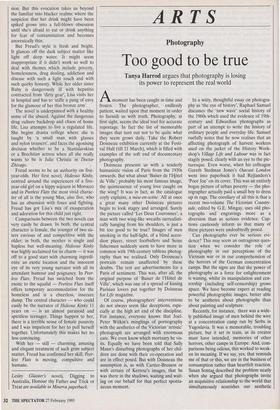From the exotic to the squalid
Lesley Glaister
PEERLESS FLATS by Esther Freud Hamish Hamilton, £14.99, pp. 192 In Peerless Flats Esther Freud gives not just a twist to the usual adolescent tale but a painful yank. Sixteen-year-old Lisa longs for the rules most adolescents love to break. She is uneasy in a world where she dare not refuse to smoke a joint in front of her new neighbours for fear of letting her mother down; where her mother doesn't complain or even question her when she stays out all night. On her reluctant way to sleep with her new drug-addict boyfriend she thinks wistfully about her mother and how she has 'destroyed, one by one, the last excuses of her childhood'.
Freud convincingly conveys the fears and failures of nerve common in adolescence. Lisa agonises how, with aplomb but no tray, to convey three bottles of lager and three glasses from bar to table; she hangs around in shops for hours in vain attempts not to be the first to arrive at every occa- sion. But this evocation takes us beyond the familiar into blacker realms: where the suspicion that her drink might have been spiked grows into a full-blown obsession until she's afraid to eat or drink anything for fear of contamination and becomes anorexically thin.
But Freud's style is fresh and bright. It glances off the dark subject matter like light off deep water. It might seem inappropriate if it didn't work so well to deal with themes which include poverty, homelessness, drug dealing, addiction and disease with such a light touch and with such quirky honesty. While her older sister Ruby is dangerously ill with hepatitis contracted from 'dirty gear', Lisa visits her in hospital and has to 'stifle a pang of envy for the glamour of her thin bronze arm'.
The novel is underpinned with a healthy sense of the absurd. Against the dangerous drug culture backdrop and chaos of home life, Lisa attempts to live a regulated life. She begins drama college where she is taught by 'a small man with glasses and nylon trousers', and faces the agonising decision whether to be a Stanislayskian or a Brechtian actress when all she really wants to be is Julie Christie in Doctor Zhivago.
Freud seems to be an authority on five- year-olds. Her first novel, Hideous Kinky, centred around the experiences of a five- year-old girl on a hippy sojourn in Morocco and in Peerless Flats the most vivid charac- ter of all is the young Max, also five, who has an obsession with foxes and fighting. Freud has got Lisa's mix of exasperation and adoration for this child just right.
Comparisons between the two novels can very easily be drawn. In both, the central character is female, the younger of two sis- ters envious of and competitive with the older; in both, the mother is single and hapless but well-meaning. Hideous Kinky was highly acclaimed for its charm — it was off to a good start with charming ingredi- ents: an exotic location and the innocent eye of its very young narrator with all its attendant humour and poignancy. In Peer- less Flats, Freud has switched from the exotic to the squalid — Peerless Flats itself offers temporary accommodation for the homeless and is a cheerless, insecure dump. The central character — who could easily be the narrator of Hideous Kinky 11 years on — is an almost paranoid and spiritless teenager. Things happen to her, there is a terrible sense of female passivity and I was impatient for her to pull herself together. Unfortunately this makes her no less convincing.
With her — still — charming, amusing and elegant treatment of such grim subject matter, Freud has confirmed her skill. Peer- less Flats is moving, compulsive and humane.
Lesley Glaister's novels, Digging to Australia, Honour thy Father and Trick or Treat are available in Minerva paperback



















































 Previous page
Previous page